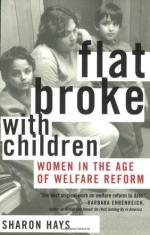|
This section contains 1,069 words (approx. 4 pages at 300 words per page) |

|
In August 1996, Bill Clinton fulfilled his 1992 campaign pledge to “end welfare as we know it” when he signed the Personal Responsibility and Work Opportunity Reconciliation Act. Upon signing this landmark law (after twice vetoing similar legislation submitted by the Republican- controlled Congress), Clinton announced, “We are taking an historic chance to make welfare what it was meant to be: a second chance, not a way of life.”
Most Americans—including members of Congress—welcomed legislation ending the federal government’s unlimited entitlement program known as Aid to Families with Dependent Children (AFDC). The backbone of the 1996 act—time limits as short as thirty days on cash assistance to the nonworking poor—was a feature that had appeared in both Clinton’s proposed Work and Personal Responsibility Act of 1994, which Congress declined to vote on, and the Republicans&rsquo...
|
This section contains 1,069 words (approx. 4 pages at 300 words per page) |

|



